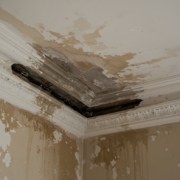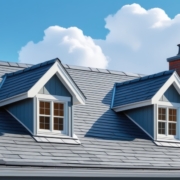Trouble Overhead? Common Roof Leak Causes in Hallsville, MO
A leaking roof doesn’t always start with a major storm. Sometimes, all it takes is one cracked pipe boot, a clogged gutter, or a few missing shingles to cause serious water damage. In Hallsville, where seasonal storms and temperature swings are the norm, these small issues can quickly turn into costly repairs if ignored.
As a trusted roofing contractor serving Mid-Missouri for over 15 years, we’ve seen firsthand how roof leaks can sneak up on homeowners—and how preventable many of them are.
In this guide, we’ll walk you through the most common roof leak causes in Hallsville, MO, and what to do if you notice the signs inside your home.
Let’s take a closer look at what’s really behind those ceiling stains and dripping water.
Key Takeaways
- A roof leak in Hallsville often starts with damaged shingles, flashing issues, clogged gutters, or cracked pipe boots.
- Ice dams, tree debris, roof vents, and skylights can all cause hidden leaks that lead to serious water damage.
- Quick action, like containing the leak, calling a roofer, and documenting damage, helps prevent further costly repairs.
- Trusted Hallsville contractors offer repairs, inspections, and insurance help with a lifetime workmanship warranty.
Damaged Shingles from Storms and Aging
In Hallsville, MO, the combination of seasonal thunderstorms and intense summer heat can take a toll on asphalt shingles.
Over time, this constant exposure breaks down roofing material, causing cracks or complete loss of shingles. Once shingles are compromised, water can seep through to the underlayment and decking. Damaged shingles are among the most common causes of roof leaks in Mid-Missouri homes.
To avoid leaks, schedule regular inspections—especially after hail or windstorms—and replace missing shingles promptly. Installing new shingles where necessary helps prevent further damage from water intrusion and extends the life of your roof.
Cracked Neoprene Pipe Boots Around Vents
One of the most overlooked but most common causes of a leaky roof is a cracked neoprene pipe boot.
These rubber gaskets seal the base of pipes protruding through the roof and are vulnerable to cracks due to constant exposure to UV rays and temperature swings. When a pipe boot cracks, it creates a direct path for water to enter your attic or cause a leak inside your walls.
Addressing this minor issue quickly helps prevent water damage and mold growth.
These are simple but important repairs that can minimize damage and reduce the risk of costly repairs later on.
Failing Flashing Near Chimneys and Valleys
Improper installation of flashing, or aging materials around chimneys and valleys, are major contributors to a leaking roof. These metal strips are essential for maintaining proper water flow and preventing leaks where the roof meets joints, skylights, or siding transitions.
When flashing issues go unaddressed, they can lead to structural issues and significant damage, especially if water penetrates near the V-shape formed by valleys.
Routine inspection for flashing problems is key to preventing future leaks and potential issues.
Clogged Gutters and Poor Water Flow
With fall leaves from local oaks and maples, clogged gutters are a frequent source of roof leaks in Hallsville. When gutters become blocked, water backs up under shingles and flows down exterior walls, sometimes creating interior water stains and even damaging the ceiling.
Regularly clearing gutters of leaves and other debris ensures proper water flow away from your home. Installing gutter guards and inspecting downspouts after storms also helps prevent water damage and the formation of ice dams in winter.
Nail Pops and Roofing Nails in Good Wood
Over time, roofing nails can pop out of decking—especially if a nail hits good wood and then backs out due to expansion, contraction, or impact from wind.
These nail pops create tiny openings in your roofing shingles, leading to leaks that may not be visible until ceiling stains appear.
Left unchecked, this minor issue can escalate into a homeowner’s nightmare involving costly roof repairs or even partial replacement. Prompt roof leak repair by experienced roofers helps maintain the integrity of your roofing system.
Ice Dams and Inadequate Ice and Water Shield
Ice dams form when snow melts on warm roof sections and refreezes near colder eaves, trapping water beneath the shingles. Without a properly installed ice and water shield, this trapped water can leak inside, causing water damage and wall water stains.
Installing a water shield beneath the shingles—especially on lower slopes and around roof edges—helps prevent future leaks and protects against long-term storm damage. Proper attic ventilation and insulation also reduce the risk of ice dams forming during Hallsville winters.
Tree Branch Damage and Other Debris
Tree branches that scrape or fall on roofs during Hallsville’s frequent storms can puncture roofing material or knock shingles loose. Combined with other debris like twigs, leaves, or nuts, this can block roof vents, damage flashing, or wear down protective granules on shingles.
Prevent water by trimming back overhanging limbs and clearing debris off your roof regularly.
Even small cracks from falling branches can quickly turn into larger issues if not addressed.
Skylights and Roof Vents
Skylights and roof vents can become leak points when seals degrade or flashing is compromised. Water can enter through improperly sealed skylight frames or roof vent flanges, especially during wind-driven rain events common in Mid-Missouri.
Regular inspections and sealing around skylights, pipes, and roof vents help prevent leaks and extend the performance of your roof. Poor sealing can also lead to mold growth and long-term indoor air quality concerns.
What to Do If You Find a Roof Leak in Your Hallsville Home
If you suspect a roof leak in your Hallsville home, take these steps right away to minimize damage and get the right repair solution in place.
Locate the Source of the Leak Inside First
If you notice dripping water, stained ceilings, or peeling paint, start by inspecting your attic. Bring a flashlight and check for moisture near pipes, flashing, and rafters.
Even minor issues in these areas can lead to further damage if ignored.
Look for signs of leaking, such as water-damaged insulation or visible cracks in the roofing deck. These early indicators help you identify the root cause of the leak before it causes costly structural damage.
Call a Local Professional for a Roof Inspection
Once you spot a leak, call a reputable Hallsville roofing company for a thorough inspection.
A professional roof leak repair contractor will check everything from flashing to nails to ensure no issues are missed. At CoMo Premium Exteriors, we provide free roof inspections and specialize in fixing roof leaks across Mid-Missouri.
Partnering with experienced roofing companies like us ensures the problem is resolved correctly, not temporarily patched.
Temporarily Contain the Leak to Prevent Further Damage
Use buckets, plastic sheeting, or towels to contain any leak inside until help arrives.
If water is dripping onto floors or furniture, move valuables away to prevent water damage. Containment is a critical first step to avoid costly repairs from spreading.
If it’s safe, cover the leaking roof area with a tarp, but don’t risk climbing on slippery metal roofs or steep slopes. Leave that to professionals.
Avoid DIY Fixes on Leaky Roofs
While minor caulking or patching might seem like a quick solution, improper repairs often do more harm than good. Incorrect use of roofing nails, shingles, or sealants can result in future issues or void warranties.
Trust a professional who understands Hallsville’s weather patterns and roof types—from asphalt shingles to metal roofs—to repair leaks the right way.
Document the Damage for Insurance
For storm-related roof repairs, document everything.
Take photos of the leaking areas, ceiling stains, and any visible roof damage. Insurers often require clear evidence of storm damage or improper installation before approving claims.
At CoMo Premium Exteriors, our experienced team helps guide Hallsville homeowners through this process, offering support from inspection through claim submission—ensuring your roof gets the proper coverage and repair.
Protect Your Hallsville Home from Future Roof Leaks
Our crews around Missouri are proud to be Owens Corning Platinum Preferred and GAF Master Elite contractors—credentials that reflect our commitment to quality, customer satisfaction, and lasting craftsmanship.
From replacing roofing material and flashing to installing leak-preventing ice and water shields, we focus on long-term performance. If you’ve spotted a leak—or want to prevent future issues—contact us today to schedule your free inspection.
Frequently Asked Questions
What roofing material lasts the longest in Mid-Missouri weather?
Metal roofs and impact-rated shingles offer the best long-term performance. We install high-quality roofing material built for Hallsville storms and back every job with our Limited Lifetime Workmanship Warranty.
Is a leaky roof always visible from the outside?
A leaky roof may not show exterior damage. Inside, look for signs like walls water stains or musty smells. Our inspections detect hidden issues before they cause major structural damage.
How do I know if a leaking roof repair will be covered by insurance?
If storm damage caused the leaking roof, it may be covered by your policy. We help document damage, meet with adjusters, and ensure eligible repairs are fully supported and approved.
Why hire a pro instead of doing a professional-looking repair yourself?
DIY roof fixes may miss deeper problems. We provide expert repairs that protect your home, prevent future leaks, and ensure lasting value with professional-grade materials and skilled craftsmanship.


